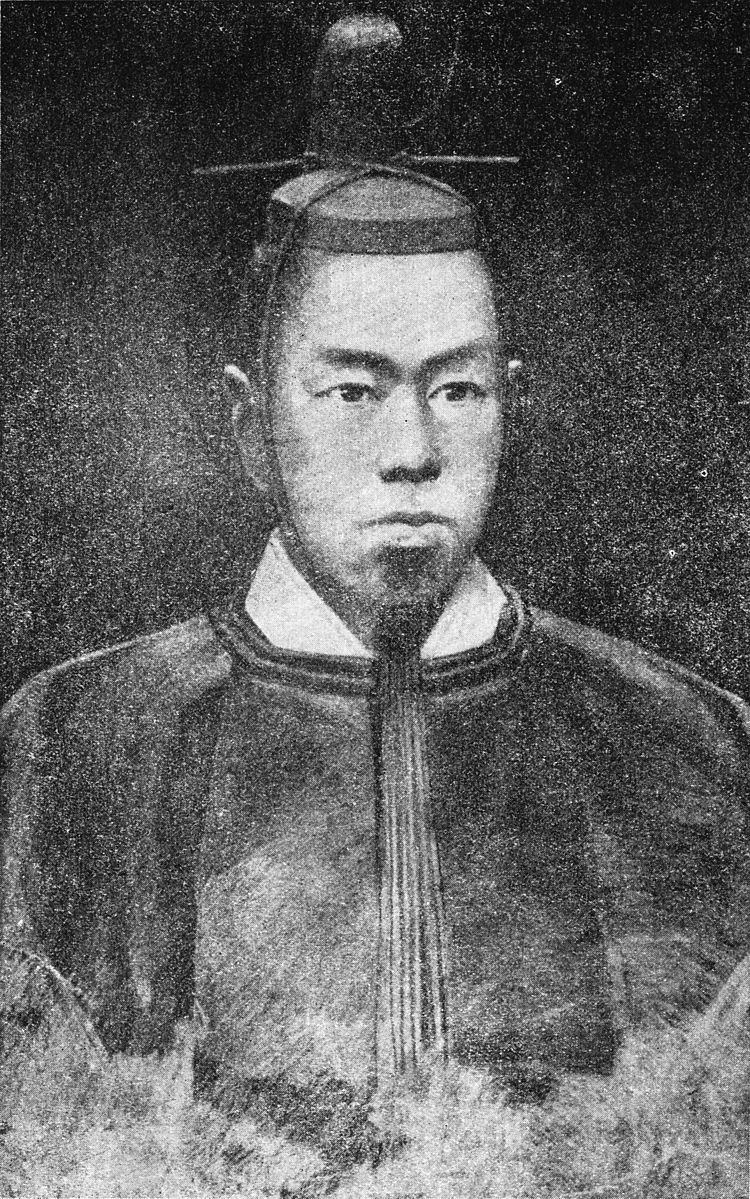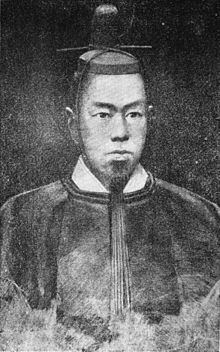Enthronement 10 March 1846 Successor Meiji | Predecessor Ninko Name Emperor Komei | |
 | ||
Reign 10 March 1846 – 30 January 1867 Born 22 July 1831 ( 1831-07-22 ) Died 30 January 1867(1867-01-30) (aged 35) | ||
Komei vs lewis
Emperor Kōmei (孝明天皇, Kōmei-tennō, 22 July 1831 – 30 January 1867) was the 121st emperor of Japan, according to the traditional order of succession.
Contents
- Komei vs lewis
- Fall of the Samurai Darthmod 50 Nagaoka 01 The Tycoons
- Genealogy
- Events of Kmeis life
- The Order to Expel Barbarians
- Kugy
- Eras of Kmeis reign
- References

Kōmei's reign spanned the years from 1846 through 1867.
Fall of the Samurai | Darthmod 5.0 | Nagaoka | #01 | The Tycoons
Genealogy
Before Kōmei's accession to the Chrysanthemum Throne, his personal name (imina) was Osahito (統仁); his title was Hiro-no-miya (煕宮).
Emperor Kōmei was the fourth son of Emperor Ninkō and his consort Fujiwara-no-Tsuneko (藤原雅子). Kōmei's Imperial family lived with him in the Dairi of the Heian Palace. The family included six children, four daughters and two sons; but the future Emperor Meiji was the only one to survive childhood.
The Kōmei principal consort was Asako Kujō (九条夙子). After Kōmei's death in 1867, Asako was given the title Empress Eishō (英照皇后) by Emperor Meiji.
Events of Kōmei's life
Osahito-shinnō became emperor following the death of his emperor-father. The succession (the senso) was considered to have been received by the new monarch; and shortly thereafter, Emperor Kōmei is said to have acceded (the sokui). The events during his lifetime shed some light on his reign. The years of Kōmei's reign correspond with a period in which Tokugawa Ieyoshi, Tokugawa Iesada, Tokugawa Iemochi, and Tokugawa Yoshinobu were leaders at the pinnacle of the Tokugawa shogunate.
With the arrival of US Commodore Matthew Perry and his "Black Ships" on 8 July 1853, Japan began its transformation into a modern industrial power. The Tokugawa Shogunate, which had controlled military and civil affairs in Japan's feudal provinces for some three centuries, proved unable to meet the new challenge of open trade with the West.
At the time, Emperor Kōmei still retained only symbolic power at his court in Kyoto. As the Shogunate, divided by internal disputes, gradually surrendered sovereignty to the foreign powers, under threat of military force, Emperor Kōmei began to assert himself and regain many of the powers his ancestors had conceded to the Tokugawa clan at the close of the Sengoku (warring states) period.
The Emperor's younger sister, Imperial princess Kazu-no-Miya Chikako (和宮親子内親王) was married to the Tokugawa shogun Tokugawa Iemochi as part of the Movement to Unite Court and Bakufu. Both the Emperor and his sister were against the marriage, even though he realized the gains to be had from such familial connections with the true ruler of Japan. Emperor Kōmei did not care much for anything foreign, and he opposed opening Japan to Western powers, even as the shogun continued to accept foreign demands.
The pilgrimage of the 14th shogun Tokugawa Iemochi to Kyoto in 1863 was a defining moment not only in 19th century relations between the military bakufu and the Imperial Court, but also in what history would come to call the Meiji Restoration.
The reception by Emperor Kōmei of the shogun in the Kyoto palace can be seen as a moment at which the political realm was thoroughly redefined, becoming a transitional imperial realm. This impression was enforced by the ensuing pilgrimage by Emperor Kōmei to the Kamo shrine, with the shogun in tow. This public demonstration showed that a new order had now emerged in the realm.
The "Order to Expel Barbarians"
By the time of Emperor Kōmei's death in 1867, the government was faced with bankruptcy and near collapse. In addition, Japan was surrounded by colonial powers, with substantial investments in Japanese trade, who stood poised to gain considerable influence. Unequal trade treaties with the Western powers, such as the Treaty of Kanagawa and the Harris Treaty were signed without Imperial sanction and in spite of the Emperor's refusal to approve them. He twice expressed his will to resign from his position in protest.
Emperor Kōmei was infuriated with nearly every development during his reign as emperor. In his lifetime he never saw any foreigners and he knew little about them. During his reign he started to gain more power as the Tokugawa shogunate declined, though this was limited to consultation and other forms of deference according to protocol.
Emperor Kōmei generally agreed with anti-Western sentiments, and, breaking with centuries of imperial tradition, began to take an active role in matters of state. As opportunities arose, he fulminated against the treaties and attempted to interfere in the shogunal succession. His efforts culminated in 1863 with his "Order to expel barbarians". Although the Shogunate had no intention of enforcing the order, it nevertheless inspired attacks against the Shogunate itself and against foreigners in Japan: the most famous incident was the slaying of British trader Charles Lennox Richardson, for which the Tokugawa government paid an indemnity of one hundred thousand British pounds. Other incidents included the bombardment of Shimonoseki and Kagoshima, and the destruction of Japanese warships, coastal guns, and assorted military infrastructure throughout the country. These incidents showed that Japan could not match the military might of the Westerners, and that confrontation could not be the solution.
In January 1867 the emperor was diagnosed with smallpox. This caused surprise because it was said that Kōmei had never been ill before. On 30 January 1867 he suffered a fatally violent bout of vomiting and diarrhea. He had purple spots on his face. Since he had consistently opposed the anti-bakufu forces this was distinctly convenient for them and it was rumored that he was assassinated, either by radicals from Choshu or radical officials in the court. However, there is no evidence of this and it is generally believed that he was simply one more victim of what was a worldwide pandemic at the time.
After Kōmei's death in 1867, his kami was enshrined in the Imperial mausoleum, Nochi no Tsukinowa no Higashi no misasagi (後月輪東山陵), which is at Sennyū-ji in Higashiyama-ku, Kyoto. Also enshrined in this mausoleum complex are Kōmei's immediate predecessors since Emperor Go-Mizunoo: Meishō, Go-Kōmyō, Go-Sai, Reigen, Higashiyama, Nakamikado, Sakuramachi, Momozono, Go-Sakuramachi, Go-Momozono, Kōkaku and Ninkō. Empress Dowager Eishō is also entombed at this Imperial mausoleum complex.
Emperor Kōmei was the last emperor to be given a posthumous name chosen after his death. Beginning with the reign of his son, Emperor Meiji, posthumous names were chosen in advance, being the same as their reign names.
Kugyō
Kugyō (公卿) is a collective term for the very few most powerful men attached to the court of the Emperor of Japan in pre-Meiji eras. Even during those years in which the court's actual influence outside the palace walls was minimal, the hierarchic organization persisted.
In general, this elite group included only three to four men at a time. These were hereditary courtiers whose experience and background would have brought them to the pinnacle of a life's career. During Kōmei's reign, this apex of the Daijō-kan included:
Eras of Kōmei's reign
Emperor Kōmei was the last Japanese Emperor who had more than one era name (nengō) during a single ruling term. Beginning with his successor, Emperor Meiji, a single era name (identical to the Emperor's official title) was selected and did not change until his death. There were seven nengō during Kōmei's reign.
